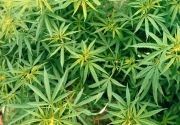THC:CBD Spray Improves MS-Associated Spasticity and Maintains Improvements throughout Long-term Treatment
Patients treated with oromucosal nabiximols spray experienced up to 30% reduction in spasticity, as measured by a numerical rating scale, after 12 months of treatment.

Copenhagen, Denmark — October 4, 2013 – THC:CBD oromucosal spray (nabiximols) may provide a new long-term treatment option for patients with multiple sclerosis (MS) associated spasticity, a common and disabling symptom of MS that frequently is resistant to oral medication. THC:CBD is a preparation containing a defined quantity of specific cannabinoids.
Spasticity one of the most common problem for patients with MS and can occur in up to 84% of patients. The definition of spasticity includes both feelings of stiffness and a wide range of involuntary muscle spasms due to sustained muscle contractions. With THC:CBD treatment, mean spasticity, as measured by a numerical rating scale (NRS), was significantly reduced during a one year period from 6.2 at baseline to 4.6 at 12 months (P<0.0001). The majority, (53%) of patients showed a 20% reduction in spasticity, while 41% of patients achieved a 30% reduction by the NRS score.
Findings from the MOVE-2 study were compiled in a poster by Peter Flachenecker, professor at the Neurological Rehabilitation Center Quellenhof in Bad Wildbad and colleagues. Their study was discussed on October 4 during the Treatment of Specific Symptoms session of the 29th Congress of the European Committee for Treatment and Research in Multiple Sclerosis (ECTRIMS) and the 18th Annual Conference of Rehabilitation in MS by Carlos Vila, MD, PhD, of Almirall S.A., the study co-ordinator.
According to the authors, THC:CBD oromucosal spray had shown promise in clinical placebo-controlled trials with patients whose spasticity symptoms remained resistant to therapy responding well to this treatment, but there remained a paucity of data on the long term effects, especially regarding quality of life in these patients. MOVE-2 is an open, prospective, observational study that was conducted during routine clinical practice. MOVE-2 was a follow-up of patients with resistant spasticity who showed an initial response to THC:CBD oromucosal spray that was designed to determine the long-term clinical evolution after one year of treatment.
Patients enrolled in 25 MS centers throughout Germany were evaluated at baseline, 1, 3, and 12 months. The main study parameters included the degree of spasticity during the past 24 hours, the degree of sleep disturbance (measured by the NRS) Health-Related Quality of Life, treatment satisfaction, both patients and physicians, and tolerability. Patient response was evaluated by the following parameters: spasticity and sleep, measured on a 0-10 numerical rating scale (NRS), spasms count, tolerability and quality of life, measured by the EuroQol 5-dimension index (EQ-5D) and Multiple Sclerosis Quality of Life-54 Instrument (MSQoL-54).
Based on a comparison of disease parameters from baseline to month 3, it was determined that 55.3% of previously resistant MS patients showed clinical response to THC:CBD by their treating neurologist. Of these, 104 were enrolled in the one year, long-term follow-up study. Data at one year were available for 52 (50%) patients; 31 (29.8%) patients discontinued the trial by request and 22 patients were missing and/or lost to follow up. The mean age of patients with one year data was 49.4years and just over half (55.8%) were female. Patients received an average dose of THC:CBD of 6.2 sprays per day (standard deviation [SD] 2.61) which was given mostly in combination with other antispastic drugs that included mainly baclofen, tizanidine and tolperison; this use of adjunct therapy decreased to 28 (53.8%) patients after 12 months of THC:CBD.
At 12 months most patients showed improvement in several measures. The mean sleep NRS scores from baseline decreased from 5.1 to 3.2 (37%; P<0.0001). Spasticity scores at 12 months had decreased from 6.2 to 4.6 (26%) from baseline, and the mean number spasms per day count decreased from 6 to 3 (P=0.005). Mean EDSS remained stable after one year at 6.4, but this score improved by 0.2 in those patients with improved spasticity changes of 20% or more, as measured by NRS. Mean MSQoL-54 scores of the physical health component increased from 36.0 to 39.4. “We would like to see greater improvements but most scores for sleep disturbance and spasticity improved by about 10 points — this means patients feel less fatigue during the day because they slept better the night before,” Vila said.
Self-reported quality of life also improved in patients with NRS changes of 20% or more. In this group, quality of life as reported on the EQ-5D improved 0.1 points and by 8 points in the MSQoL-54 scale (P=0.01). The proportion of patients who reported being satisfied with their treatment rose from 48.5% prior to receiving THC:CBD to 92.2% following 12 months of THC:CBD therapy.
Between months three and twelve, 21 treatment-related adverse events (AEs) occurred in 17 (16.3%) patients, with one AE that considered serious; 12 AEs involved the CNS and 5 the oral mucosal area. A total of 8 (7.7%) patients discontinued treatment due to AEs. “Unfortunately, controlling the symptom of spasticity has not had an effect on the number of falls observed in this or other Phase 3 trials that are ongoing,” said Vila.
At least half of patients who initially responded to THC:CBD oromucosal spray remained on treatment after one year and continued to maintain improved improvements in spasticity, sleep, spasm and quality of life parameters. “It is remarkable that over 90% of patients and their physicians were satisfied with the level of spasticity control. We see this as a relief, not a solution of patients’ underlying MS, but a relief that lets patients be able to walk more confidently, to be more independent and enjoy their lives more with less need for nursing support,” Vila said.
MOVE-2 was sponsored by Almirall S.A., Barcelona, Spain.